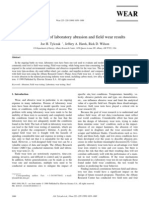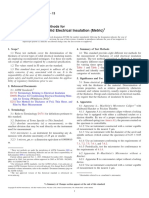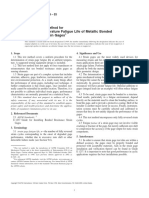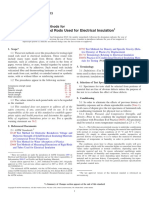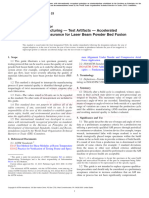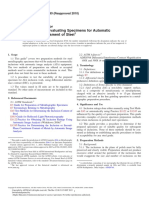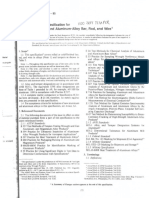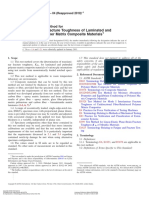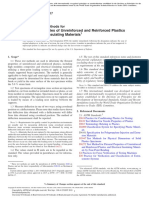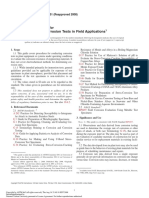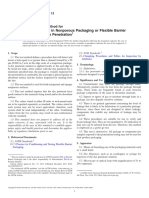Astm G204 - 10
Astm G204 - 10
Uploaded by
Sofia YuliOriginal Title
Copyright
Available Formats
Share this document
Did you find this document useful?
Is this content inappropriate?
Report this DocumentCopyright:
Available Formats
Astm G204 - 10
Astm G204 - 10
Uploaded by
Sofia YuliCopyright:
Available Formats
Designation: G204 – 10
Standard Test Method for
Damage to Contacting Solid Surfaces under Fretting
Conditions1
This standard is issued under the fixed designation G204; the number immediately following the designation indicates the year of
original adoption or, in the case of revision, the year of last revision. A number in parentheses indicates the year of last reapproval. A
superscript epsilon (´) indicates an editorial change since the last revision or reapproval.
--``,``,````````,`,,``,,``,``,,-`-`,,`,,`,`,,`---
INTRODUCTION
Fretting is small amplitude oscillating motion usually in the range of 10 to 300 µm. Contacting solid
surfaces subjected to this type of motion can develop significant damage in the form of mass loss,
pitting, debris generation, etc. Frequently, pitting damage caused by fretting creates stress concentra-
tions that contribute to mechanical failures. Most material couples are susceptible to fretting damage
and this test method is intended to assess a tribocouple’s relative susceptibility to damage under
fretting conditions.
When tribocouples experience oscillating relative motion less than about 10 µm, gross slip (all
points in a contact experience relative slip over a complete cycle) may not occur. The elastic behavior
of the real contacts may accommodate this motion and fretting damage may not occur.
When metal couples are subjected to fretting motion, there is a potential for chemical reaction with
the ambient environment to be a component of the damage. In metals rubbing in air, oxidation of
freshly fractured surfaces can occur. When chemical reaction is conjoint with the mechanical damage
produced by fretting, it is called fretting corrosion. When most plastic couples are damaged by fretting
motion, the fractured surfaces may not react with the environment and fretting wear occurs as opposed
to fretting corrosion.
1. Scope 1.5 This standard does not purport to address all of the
1.1 This test method covers the studying or ranking the safety concerns, if any, associated with its use. It is the
susceptibility of candidate materials to fretting corrosion or responsibility of the user of this standard to establish appro-
fretting wear for the purposes of material selection for appli- priate safety and health practices and determine the applica-
cations where fretting corrosion or fretting wear can limit bility of regulatory limitations prior to use.
serviceability. 2. Referenced Documents
1.2 This test method uses a tribological bench test apparatus
with a mechanism or device that will produce the necessary 2.1 ASTM Standards:2
relative motion between a contacting hemispherical rider and a G40 Terminology Relating to Wear and Erosion
flat counterface. The rider is pressed against the flat counter- G99 Test Method for Wear Testing with a Pin-on-Disk
face with a loading mass. The test method is intended for use Apparatus
in room temperature air, but future editions could include G133 Test Method for Linearly Reciprocating Ball-on-Flat
fretting in the presence of lubricants or other environments. Sliding Wear
1.3 The purpose of this test method is to rub two solid 3. Terminology
surfaces together under controlled fretting conditions and to
quantify the damage to both surfaces in units of volume loss for 3.1 Definitions:
the test method. 3.1.1 fretting, n—in tribology, small amplitude oscillating
1.4 The values stated in SI units are to be regarded as motion usually tangential between two solid surfaces in con-
standard. No other units of measurement are included in this tact. G40
standard. 3.1.2 fretting corrosion, n—form of fretting wear in which
corrosion plays a significant role. G40
1
This test method is under the jurisdiction of ASTM Committee G02 on Wear
2
and Erosion and is the direct responsibility of Subcommittee G02.40 on Non- For referenced ASTM standards, visit the ASTM website, www.astm.org, or
Abrasive Wear. contact ASTM Customer Service at service@astm.org. For Annual Book of ASTM
Current edition approved April 1, 2010. Published April 2010. DOI:10.1520/ Standards volume information, refer to the standard’s Document Summary page on
G0204–10. the ASTM website.
Copyright © ASTM International, 100 Barr Harbor Drive, PO Box C700, West Conshohocken, PA 19428-2959, United States.
Copyright ASTM International
Provided by IHS under license with ASTM
1Licensee=Committee on Institutional Cooperation/5967164001
No reproduction or networking permitted without license from IHS Not for Resale, 02/04/2012 05:14:55 MST
G204 – 10
FIG. 1 Schematic of a Suitable Fretting Testing Rig
a = loading arm pivot
b = counterface test specimen
c = rider test specimen
d = device to measure rider movement
e = device to measure counterface movement
3.1.3 fretting wear, n—wear arising as a result of fretting. rubbing on a product in transit can make the product unsalable.
G40 Beverage cans and food cans can lose their trade dress and
3.2 Definitions of Terms Specific to This Standard: consumers often equate container damage to content damage.
3.2.1 coeffıcient of variation (COV), n—test standard devia- 5.2 Clamping surfaces on injection molds are damaged by
tion divided by the test mean. fretting motions on clamping. This damage is a significant
3.2.2 counterface, n—flat surface that the rider rubs on in cause for mold replacement.
this test. 5.3 Machines in shipment are subject to fretting damage in
3.2.3 crater, n—counterface damage in a fretting test from the real area of contact of the bearings on the machines.
a hemispherical or spherical rider characterized by loss of 5.4 Operating vibration and movement of mechanically
material in the form of a surface depression. clamped components, like screwed assemblies, can produce
3.2.4 fretting amplitude, n—sliding distance between direc- damage on the clamped faces and other faces that affects
--``,``,````````,`,,``,,``,``,,-`-`,,`,,`,`,,`---
tion reversals (for example, if a dial indicator is used to machine function or use. Many times fretting damage appears
measure stroke, the amplitude is the indicator movement on the in the form of pits, which are stress concentrators that can lead
dial). to mechanical fractures.
3.2.5 rider, n—ball or hemisphere that oscillates on another 5.5 Electrical contacts in any device that is subject to
surface to produce fretting damage. vibration are susceptible to failure (open circuit) due to fretting
3.2.6 scar, n—damage to either rider or counterface in a damage at real areas of contact.
fretting test. 5.6 This test method is intended to be used to identify
mating couples that may be less prone to fretting damage than
4. Summary of Test Method others. This information in turn is used to select materials of
4.1 This test method rubs a spherical or hemispherical solid construction or surface treatments that are less prone to fretting
rider on a solid flat under prescribed conditions to produce damage for applications where fretting conditions are known or
fretting damage on one or both surfaces. If damage occurs, it is perceived to exist.
quantified as a wear volume on each member and as system
wear, the sum of the rider and counterface wear. 6. Apparatus
4.2 Friction forces can be measured during the fretting test, 6.1 Fig. 1 is a schematic of the test apparatus showing
but these measurements, as well as reporting these data, is necessary features. The schematic shows the counterface
optional. moving laterally with respect to the rider. The rider could
reciprocate with respect to the counterface as long as it still can
5. Significance and Use move in the downward direction to accommodate wear.
5.1 Fretting wear and corrosion are potential serviceability 6.2 The rider or counterface holder can be instrumented to
factors in many machines. They have always been factors in sense friction force, but the device cannot interfere with
shipping finished goods by truck or rail. Packing materials achieving the required relative motion between the rider and
Copyright ASTM International
Provided by IHS under license with ASTM
2Licensee=Committee on Institutional Cooperation/5967164001
No reproduction or networking permitted without license from IHS Not for Resale, 02/04/2012 05:14:55 MST
G204 – 10
FIG. 2 Fretting Test Specimens
A = counterface
B = rider (a ball may be adhered to a pin to make the rider)
Surface roughness of both specimens = < 0.1 µm Ra
counterface. Test rigs need instrumentation or a system to point of contact. The test specimens used in the development of
verify that the amplitude of oscillation is the test value of 50 6 this test method are shown in Fig. 2.
2 µm at test frequency. 7.2 Measuring wear scars with surface analysis instruments
6.3 The test specimens must be affixed to the test rig in such can be very challenging. The standard test was developed with
a manner that their movement in specimen clamps is less than surface roughnesses on both rider and counterface of less than
1 µm during testing. 0.1 µm Ra. Surface finish can play a role in susceptibility to
6.4 Wear in the specified test can be such that vertical fretting damage. Polished surfaces produce the most succinct
motion of the rider as wear occurs can be hundreds of wear scars. Very rough surfaces (> 1 µm Ra) may produce
micrometers. Thus, the test rig should be designed such that the hard-to-measure scars. Sometimes, only the rider wears; some-
rider can move into the counterface at least 500 6 20 µm. times only the counterface wears; sometimes both members
6.5 The test specimens should be protected from environ- wear. Test Method G99 and G133 describe wear scar measure-
mental contamination during testing and testing should be done ment in detail.
in an atmosphere that stays consistent in nature throughout the 7.3 Some surfaces of interest, like thermal spray deposits,
test. The standard test is performed in ordinary laboratory air at are often incapable of being ground and lapped to this
20°C, 50 to 70% RH. roughness. They can be tested, but the users need to establish
6.6 The test rig shall be capable of an oscillating frequency the effect of excessive roughness on repeatability. The COV
of 13 6 0.8 Hz (see Note 1). Most test rigs have variable may be high for these test couples.
frequency capability, and it is not usual to design a rig for a 7.4 The surface lay of the test specimens can affect results
--``,``,````````,`,,``,,``,``,,-`-`,,`,,`,`,,`---
wide frequency range. Mechanical actuators are usually ad- and care should be taken to produce non-directional lay in the
equate for frequencies in the range of 1 to 50 Hz. Higher test counterface and accurate curvature (no centerline protuberance
frequencies usually require piezocrystals or the like as a source greater than 1 µm on the rider). If test surfaces have a distinct
of oscillation. The standard test was developed using mechani- lay, the relationship of the rubbing to the lay (parallel or
cal activation (electric motor driven crank). perpendicular) should be kept the same for each test couple.
NOTE 1—This frequency was chosen for convenience. It produces 106 7.5 Grain direction can be a factor in both counterface and
cycles in about 21.4 h. Users can do a test a day. rider in crystalline materials. It is acceptable to ignore grain
orientation in ground balls, but the grain orientation in the
7. Test Specimens counterface should simulate the application. The test was
7.1 The test specimens used in this test method can vary in developed with counterfaces produced as flat-rolled steel and
shape as long as the rider has a 3.17 mm radius at the point of testing was performed on the flat surfaces as opposed to end
contact and the counterface is flat within 1 µm per cm at the grain.
Copyright ASTM International
Provided by IHS under license with ASTM
3Licensee=Committee on Institutional Cooperation/5967164001
No reproduction or networking permitted without license from IHS Not for Resale, 02/04/2012 05:14:55 MST
G204 – 10
8. Procedure Test No.
Descriptions
8.1 Clean test specimens of all films and particles. Ultra- 1. Test Couple:
sonic degreasing for 1 min in 100 mL of fresh acetone for each Rider
specimen has been determined to be adequate for metals. Clean Counterface
2. Surface Condition (Ra)
plastics and ceramics with techniques that do not contaminate Rider
or attack the test surface. Counterface
8.2 Assemble specimens into the test rig after cleaning 3. Test Force 10 N
4. Test Amplitude 50 µm
using procedures that do not contaminate the testing surfaces. 5. Test Frequency 13
Affix the rider to the rider arm and the counterface to the 6. Test Environment 20°C, 50% RH
counterface holder. Gently lower the rider onto the counterface 7. Test Duration 106 cycles
8. Rider Wear Volume
so there is no damage from this initial contact. Do not drop the 9. Counterface Wear Volume
rider on the flat. 10. System Wear Volume
8.3 Load the rider on the flat with a normal force of 10 N. 11. Friction and Other Comments
Cycle the test rig in “jog mode” for up to 100 cycles or similar
such that the relative movement between the rider and coun- FIG. 3 Sample Test Report
terface can be measured. Adjust the machine so that this
relative motion is 50 6 2 µm. 10.1.1 Specimens moved during testing, so the rubbing
8.4 When the required amplitude is achieved, commence amplitude is different than planned.
testing at 13 Hz (780 cycles/minute) and continue until 10.1.2 The dynamic fretting amplitude may be different than
reciprocating 106 cycles are completed (21.36 h) Use ultrason- the amplitude measured at startup in jog mode.
ics or other processes to clean the debris from the fretting 10.1.3 Specimens are contaminated in handling.
--``,``,````````,`,,``,,``,``,,-`-`,,`,,`,`,,`---
damaged surfaces (for example, inhibited acid etch). 10.1.4 Systemic errors in calculating wear volumes.
8.5 Measure the wear volumes on both members. If a flat is 10.1.5 Not adequately removing wear debris when measur-
worn on the spherical-shaped rider, the flat diameter can be ing scar depths and dimensions.
used to calculate a wear volume using the formulas in the G99 10.2 The repeatability of one lab using one material couple
procedure for pin-on-disk testing. Counterface wear can usu- is shown below:
ally be measured by profilometer traces through the wear Test Rider Wear Volume Counterface Wear
crater; establish the cross-section area of the crater and #8 24.27 3 10-12 2.36 3 10-12
calculate the volume swept by revolution of this area or by #9 24.27 3 10-12 2.11 3 10-12
#11 24.27 3 10-12 1.57 3 10-12
suitable other calculations. It is possible that one member of #12 26.68 3 10-12 1.65 3 10-12
the test couple will not wear. It is also possible that one
Rider average = 24.97 3 10-12, s + 1.21 3 10-12, COV = 0.048
member will adhere to the other such that the wear volume is Counterface average = 1.92 3 10-12, s = 0.37 3 10-12, COV = 0.19
really a mass increase. Most often, both members wear.
8.6 Use mass change to calculate specimen wear and 10.3 All volume losses are in cubic metres. The test couple
converted to volume using material densities, but the mass was Type 52100 steel rider at 60 HRC versus Type A2 tool
changes are usually so small that this technique may lead to a steel at 60 HRC counterface. The normal force was 10N; the
high COV, which is the test standard deviation divided by the frequency was 11.66 Hz; the test amplitude was 50 µm; the
test mean. Volume calculation from scar dimensions is the rider radius was 3.17 mm. Rider wear was measured from scar
preferred technique. diameter; counterface wear was measured by profilometry
8.7 Calculate system friction coefficients for the test. They through the center of the wear crater.
will likely vary during the test and the friction coefficient 10.4 The interlaboratory reproducibility standard deviation
averaging technique should be stated. The total friction energy and coefficient of variation will be determined upon comple-
dissipated in the test (in joules) may be useful, but it is an tion of an interlaboratory testing program and will be available
optional test metric. This standard was developed without before June 29, 2011.
friction measurement, since force measurement devices usually 10.5 Effect of Test Rig—Fretting wear and corrosion test
deflect to in order to sense force. Thus, this deflection must be results can be affected by which member is moving and which
considered in its effect on fretting amplitude. Three test is stationary, by frequency, by normal force, by environment,
replicates are a minimum for each test couple. and by system compliance. System compliance is the nature
and degree that the mating surfaces contact each other. Speci-
9. Report men geometry, type of material, the rig stiffness, and the
9.1 See Fig. 3 for a sample test report. Be sure to include the dynamics of the test rig determine compliance. The wear
wear volume of each member and the system wear volume. volumes obtained on a specific couple could vary significantly
for different machines even though the prescribed test param-
10. Precision and Bias eters are used.
10.1 There is no established absolute magnitude for the 10.6 For example, test rigs that use a loading system driven
fretting wear value that occurs with a specific mating couple, by feedback controlled stepper motors may see different results
so it is not possible to state a bias, but the following factors from the results of a test rig with dead-weight loading. A rig
could create a bias between different labs testing the same with piezoelectric crystal driver may produce different results
couple under the same conditions: with a specific couple than a rig with mechanical activation.
Copyright ASTM International
Provided by IHS under license with ASTM
4Licensee=Committee on Institutional Cooperation/5967164001
No reproduction or networking permitted without license from IHS Not for Resale, 02/04/2012 05:14:55 MST
G204 – 10
10.7 The repeatability data in this standard was obtained on to compare candidate materials or treatments. The interlabora-
a test rig with the rider stationary, dead weight loaded, and with tory tests will probably be run on non-identical rigs and the rig
the flat moving specimen attached to a flexure that was compliance effect will be determined and included in updated
reciprocated with an electric motor-driven cam. Machines with versions of this standard.
different designs may produce different wear results for the test
couple used in interlaboratory tests: 5200 rider versus A2 tool 11. Keywords
steel, but this should not be a user concern when the test is used 11.1 fretting; fretting corrosion; fretting wear
ASTM International takes no position respecting the validity of any patent rights asserted in connection with any item mentioned
in this standard. Users of this standard are expressly advised that determination of the validity of any such patent rights, and the risk
of infringement of such rights, are entirely their own responsibility.
This standard is subject to revision at any time by the responsible technical committee and must be reviewed every five years and
if not revised, either reapproved or withdrawn. Your comments are invited either for revision of this standard or for additional standards
and should be addressed to ASTM International Headquarters. Your comments will receive careful consideration at a meeting of the
responsible technical committee, which you may attend. If you feel that your comments have not received a fair hearing you should
make your views known to the ASTM Committee on Standards, at the address shown below.
This standard is copyrighted by ASTM International, 100 Barr Harbor Drive, PO Box C700, West Conshohocken, PA 19428-2959,
United States. Individual reprints (single or multiple copies) of this standard may be obtained by contacting ASTM at the above
address or at 610-832-9585 (phone), 610-832-9555 (fax), or service@astm.org (e-mail); or through the ASTM website
(www.astm.org). Permission rights to photocopy the standard may also be secured from the ASTM website (www.astm.org/
COPYRIGHT/).
--``,``,````````,`,,``,,``,``,,-`-`,,`,,`,`,,`---
Copyright ASTM International
Provided by IHS under license with ASTM
5Licensee=Committee on Institutional Cooperation/5967164001
No reproduction or networking permitted without license from IHS Not for Resale, 02/04/2012 05:14:55 MST
You might also like
- ASTM G2 - G2M - 06 (Reapproved 2011)Document8 pagesASTM G2 - G2M - 06 (Reapproved 2011)Sofia YuliNo ratings yet
- Astm F3007 - 13Document4 pagesAstm F3007 - 13Sofia YuliNo ratings yet
- Astm F3009 - 14Document4 pagesAstm F3009 - 14Sofia YuliNo ratings yet
- A Comparison of Laboratory Abrasion and Field Wear ResultsDocument11 pagesA Comparison of Laboratory Abrasion and Field Wear ResultschrisnnnNo ratings yet
- Astm G69 PDFDocument1 pageAstm G69 PDFMechWell0% (1)
- Astm G 157 1998 R-2005 PDFDocument6 pagesAstm G 157 1998 R-2005 PDFJORGE ARTURO TORIBIO HUERTANo ratings yet
- Wear Testing With A Pin-on-Disk Apparatus: Standard Test Method ForDocument6 pagesWear Testing With A Pin-on-Disk Apparatus: Standard Test Method ForGobinath VMNo ratings yet
- D3518/D3518M - 13 Standard Test Method For In-Plane Shear Response of Polymer Matrix Composite Materials by Tensile Test of A 645 LaminateDocument7 pagesD3518/D3518M - 13 Standard Test Method For In-Plane Shear Response of Polymer Matrix Composite Materials by Tensile Test of A 645 LaminateAleksandrs ArnautovsNo ratings yet
- Astm D 790-03Document13 pagesAstm D 790-03reniNo ratings yet
- D374M-13 Standard Test Methods For Thickness of Solid Electrical Insulation (Metric)Document12 pagesD374M-13 Standard Test Methods For Thickness of Solid Electrical Insulation (Metric)Salma Farooq100% (1)
- Thin Walled StructuresDocument8 pagesThin Walled Structuresnanduslns07No ratings yet
- Chapter 13 Introduction To Polymer (Edited)Document36 pagesChapter 13 Introduction To Polymer (Edited)Clementz WS100% (1)
- Lec STARCCM FoundationTrainingV2.0Document342 pagesLec STARCCM FoundationTrainingV2.0sb aliNo ratings yet
- Galling Resistance of Materials: Standard Test Method ForDocument4 pagesGalling Resistance of Materials: Standard Test Method ForKarin Soldatelli Borsato100% (1)
- Astm D4060 14Document5 pagesAstm D4060 14hadi ebrahimfathNo ratings yet
- G 196 - 08 (2016)Document6 pagesG 196 - 08 (2016)Anonymous xDvblg7N3No ratings yet
- Wear: Materials, Mechanisms and PracticeFrom EverandWear: Materials, Mechanisms and PracticeGwidon W. StachowiakNo ratings yet
- Astm G33Document3 pagesAstm G33Vikash YadavNo ratings yet
- G 123 - 00 (2015)Document10 pagesG 123 - 00 (2015)ruben carcamo100% (1)
- Astm D350.4467-1Document10 pagesAstm D350.4467-1Sundaravaradhan Iyengar100% (1)
- Astm E2818-11 PDFDocument4 pagesAstm E2818-11 PDFJhonatan CalloapazaNo ratings yet
- Astm E1949Document5 pagesAstm E1949am100% (1)
- Reporting Uniaxial Strength Data and Estimating Weibull Distribution Parameters For Advanced CeramicsDocument17 pagesReporting Uniaxial Strength Data and Estimating Weibull Distribution Parameters For Advanced CeramicsMehdi GouaderNo ratings yet
- F2129 CorrosãoDocument8 pagesF2129 Corrosão04759615440No ratings yet
- Ranking Resistance of Materials To Sliding Wear Using Block-on-Ring Wear TestDocument11 pagesRanking Resistance of Materials To Sliding Wear Using Block-on-Ring Wear TestNav Talukdar100% (1)
- Knoop and Vickers Hardness of Materials: Standard Test Method ForDocument43 pagesKnoop and Vickers Hardness of Materials: Standard Test Method ForDiana Gaviria MurilloNo ratings yet
- ASTM F363 Gaskets Corrosion TestingDocument3 pagesASTM F363 Gaskets Corrosion TestingDieguitoOmarMoralesNo ratings yet
- Softening Point of Pitches (Cube-in-Water Method) : Standard Test Method ForDocument4 pagesSoftening Point of Pitches (Cube-in-Water Method) : Standard Test Method FordanicyrNo ratings yet
- Astm A772 PDFDocument4 pagesAstm A772 PDFCristian OtivoNo ratings yet
- Estimating The Approximate Residual Circumferential Stress in Straight Thin-Walled TubingDocument3 pagesEstimating The Approximate Residual Circumferential Stress in Straight Thin-Walled TubingNilton Santillan100% (1)
- Astm C 922-14Document4 pagesAstm C 922-14Tamara Silvana Cárcamo100% (1)
- Analysis of Cast Iron by Spark Atomic Emission Spectrometry: Standard Test Method ForDocument7 pagesAnalysis of Cast Iron by Spark Atomic Emission Spectrometry: Standard Test Method ForTuan Anh100% (1)
- Influence of Aging Treatment On Mechanical Properties of 6061 AlumDocument4 pagesInfluence of Aging Treatment On Mechanical Properties of 6061 AlumMohamed NasrNo ratings yet
- Astm B487Document2 pagesAstm B487אלון ספיריהNo ratings yet
- Astm CDocument3 pagesAstm CLuis MarcosNo ratings yet
- ASTM G185 Inhib-Corros-Método Evaluación-2010Document8 pagesASTM G185 Inhib-Corros-Método Evaluación-2010Antonio BarbaNo ratings yet
- Astm D4393-10Document7 pagesAstm D4393-10Sandra LopesNo ratings yet
- Standard Test Method For Coefficient of Linear Thermal Expansion of Plastics Between 30°C and 30°C With A Vitreous Silica Dilatometer 1Document6 pagesStandard Test Method For Coefficient of Linear Thermal Expansion of Plastics Between 30°C and 30°C With A Vitreous Silica Dilatometer 1Gaurav KumarNo ratings yet
- Astm E448 82 R02 E02 PDFDocument40 pagesAstm E448 82 R02 E02 PDFPacifier NothingfaceNo ratings yet
- Astm D1895 17Document4 pagesAstm D1895 17Sonia Goncalves100% (1)
- Astm D1751-04Document2 pagesAstm D1751-04Emre DalgicNo ratings yet
- Astm 66Document3 pagesAstm 66Adams Ribeiro100% (1)
- Making and Using U-Bend Stress-Corrosion Test Specimens: Standard Practice ForDocument7 pagesMaking and Using U-Bend Stress-Corrosion Test Specimens: Standard Practice ForHadi HowaidaNo ratings yet
- ASTM D-7490-13 (Contact Angle)Document5 pagesASTM D-7490-13 (Contact Angle)T Aaa0% (1)
- Laminated Round Rods Used For Electrical Insulation: Standard Test Methods ForDocument6 pagesLaminated Round Rods Used For Electrical Insulation: Standard Test Methods Forasma hamza100% (1)
- Astm G 91 - 97 - RZKXDocument5 pagesAstm G 91 - 97 - RZKXSamuel EduardoNo ratings yet
- Astm D 816Document6 pagesAstm D 816casilvaNo ratings yet
- F2832-11 (Reapproved 2016)Document5 pagesF2832-11 (Reapproved 2016)Mohammed EldakhakhnyNo ratings yet
- ASTM-B487-20 RedlineDocument4 pagesASTM-B487-20 Redlinemarcio de rossi100% (1)
- Astm F3626 23Document3 pagesAstm F3626 23Reginald ElvisNo ratings yet
- ASTM E384-11e1Document43 pagesASTM E384-11e1Brathly Ore AlattaNo ratings yet
- Norma ASTM E208-95aDocument13 pagesNorma ASTM E208-95aCésar 11nnNo ratings yet
- ASTM G190-06 - Standard Guide For Developing and Selecting Wear TestsDocument5 pagesASTM G190-06 - Standard Guide For Developing and Selecting Wear Testsdtkraeut100% (1)
- Astm E2021Document10 pagesAstm E2021La Dy MolloNo ratings yet
- Preparing and Evaluating Specimens For Automatic Inclusion Assessment of SteelDocument5 pagesPreparing and Evaluating Specimens For Automatic Inclusion Assessment of SteelWaqas RajaNo ratings yet
- Effects of Inorganic Sealant and Brief Heat Treatments On Corrosion Behavior of Plasma Sprayed Cr2O3-Al2O3 Composite Ceramic CoatingsDocument8 pagesEffects of Inorganic Sealant and Brief Heat Treatments On Corrosion Behavior of Plasma Sprayed Cr2O3-Al2O3 Composite Ceramic CoatingsBM Q100% (1)
- d1653 Water Vapor Transmission of Organic Coating Films1Document5 pagesd1653 Water Vapor Transmission of Organic Coating Films1caronieblesNo ratings yet
- Powder Flowability Characterisation Methodology For Powder-Bed-Based Metal Additive ManufacturingDocument12 pagesPowder Flowability Characterisation Methodology For Powder-Bed-Based Metal Additive ManufacturingpnpexpertsNo ratings yet
- Norma A751Document5 pagesNorma A751Dionisio Hidalgo SanchezNo ratings yet
- E1010 16 PDFDocument4 pagesE1010 16 PDFFrancisco PizarroNo ratings yet
- Astm A768 PDFDocument4 pagesAstm A768 PDFCristian OtivoNo ratings yet
- ASTM B211-AluminumDocument10 pagesASTM B211-Aluminum오덕환Oh DuckhwanNo ratings yet
- ASTM E1922 Standard Test Method For Translaminar Fracture Thoughness of Laminated and Pultruded Polymer Matrix Composite MaterialsDocument5 pagesASTM E1922 Standard Test Method For Translaminar Fracture Thoughness of Laminated and Pultruded Polymer Matrix Composite MaterialsGiuseppeNo ratings yet
- Flexural Properties of Unreinforced and Reinforced Plastics and Electrical Insulating MaterialsDocument12 pagesFlexural Properties of Unreinforced and Reinforced Plastics and Electrical Insulating MaterialsfNo ratings yet
- Diagram Fase Fe-Fe3CDocument34 pagesDiagram Fase Fe-Fe3CAlija MuhammadNo ratings yet
- Japan: EDI CT OF GovernmentDocument29 pagesJapan: EDI CT OF GovernmentSofia YuliNo ratings yet
- ASTM G16 - 95 (Reapproved 2010)Document14 pagesASTM G16 - 95 (Reapproved 2010)Sofia YuliNo ratings yet
- Japan: EDI CT OF GovernmentDocument15 pagesJapan: EDI CT OF GovernmentSofia YuliNo ratings yet
- Astm G7G7M 13Document7 pagesAstm G7G7M 13Sofia YuliNo ratings yet
- Astm G16 - 13Document14 pagesAstm G16 - 13Sofia YuliNo ratings yet
- Astm G15 - 06Document5 pagesAstm G15 - 06Sofia YuliNo ratings yet
- Astm G7 - G7M - 13Document7 pagesAstm G7 - G7M - 13Sofia YuliNo ratings yet
- Astm G10 - 10Document3 pagesAstm G10 - 10Sofia YuliNo ratings yet
- ASTM G4 - 01 (Reapproved 2008)Document9 pagesASTM G4 - 01 (Reapproved 2008)Sofia YuliNo ratings yet
- ASTM G14 - 04 (Reapproved 2010)Document6 pagesASTM G14 - 04 (Reapproved 2010)Sofia YuliNo ratings yet
- ASTM G8 - 96 (Reapproved 2010)Document9 pagesASTM G8 - 96 (Reapproved 2010)Sofia YuliNo ratings yet
- Conventions Applicable To Electrochemical Measurements in Corrosion TestingDocument9 pagesConventions Applicable To Electrochemical Measurements in Corrosion TestingAntonio BarbaNo ratings yet
- Astm G209 - 12Document8 pagesAstm G209 - 12Sofia YuliNo ratings yet
- Astm F3052 - 14Document20 pagesAstm F3052 - 14Sofia YuliNo ratings yet
- Astm G207 - 11Document7 pagesAstm G207 - 11Sofia YuliNo ratings yet
- Astm G200 - 09Document4 pagesAstm G200 - 09Sofia YuliNo ratings yet
- Preparing, Cleaning, and Evaluating Corrosion Test SpecimensDocument9 pagesPreparing, Cleaning, and Evaluating Corrosion Test SpecimensRichard De Medeiros CastroNo ratings yet
- Astm F3069 - 14Document4 pagesAstm F3069 - 14Sofia YuliNo ratings yet
- Astm F3024 - 13Document3 pagesAstm F3024 - 13Sofia YuliNo ratings yet
- Astm F3039 - 13Document5 pagesAstm F3039 - 13Sofia YuliNo ratings yet
- Astm F3011 - 13Document3 pagesAstm F3011 - 13Sofia YuliNo ratings yet
- Astm F3036 - 13Document9 pagesAstm F3036 - 13Sofia YuliNo ratings yet
- Mechanical Testing of Steel Products-Metric: Standard Test Methods ForDocument11 pagesMechanical Testing of Steel Products-Metric: Standard Test Methods ForSofia YuliNo ratings yet
- Zinc Alloy Thermo-Diffusion Coatings (TDC) On Steel Fasteners, Hardware, and Other ProductsDocument5 pagesZinc Alloy Thermo-Diffusion Coatings (TDC) On Steel Fasteners, Hardware, and Other ProductsSofia Yuli100% (1)
- General Requirements For Zinc and Zinc Alloy ProductsDocument5 pagesGeneral Requirements For Zinc and Zinc Alloy ProductsSofia Yuli100% (1)
- Astm D5865 - 12Document19 pagesAstm D5865 - 12Sofia YuliNo ratings yet
- Copper-Beryllium Welded Heat Exchanger and Condenser Tube (UNS No. C17510)Document6 pagesCopper-Beryllium Welded Heat Exchanger and Condenser Tube (UNS No. C17510)Sofia YuliNo ratings yet
- Module II Shrink Down ApproachesDocument20 pagesModule II Shrink Down ApproachesArighna BasakNo ratings yet
- KCL KVL Lab ManualDocument9 pagesKCL KVL Lab ManualAshutosh ArpitNo ratings yet
- NCCI Design of Fixed Column Base JointsDocument23 pagesNCCI Design of Fixed Column Base JointsVădan BogdanNo ratings yet
- Building Structural Analysis and Concrete Design SpreadsheetDocument95 pagesBuilding Structural Analysis and Concrete Design SpreadsheetLeandro Baldicañas Piczon83% (6)
- Discussion Marcet BoilerDocument2 pagesDiscussion Marcet BoilerIfa Ismail100% (2)
- National Institute of Technology RourkelaDocument1 pageNational Institute of Technology Rourkelasivaji naikNo ratings yet
- Unit I Partial Differential Equations 12Document6 pagesUnit I Partial Differential Equations 12Vignesh SundaresanNo ratings yet
- Ingan Solar Cell ThesisDocument6 pagesIngan Solar Cell Thesisstacyjohnsonreno100% (1)
- Machine Design Tutorials - Week 4Document34 pagesMachine Design Tutorials - Week 4Yunsu LeeNo ratings yet
- Nano Particles in Waste Water TreatmentDocument13 pagesNano Particles in Waste Water TreatmentneetuNo ratings yet
- Lecture 3, Composite (Script)Document13 pagesLecture 3, Composite (Script)JustDen09No ratings yet
- Wide Ranging Tie Layer PerformanceDocument7 pagesWide Ranging Tie Layer PerformancealfredoNo ratings yet
- Design of FootingDocument67 pagesDesign of FootingHarlene Marie M. Ilagan100% (1)
- Integrated - Power - Designs SRP 30A 2005 DatasheetDocument5 pagesIntegrated - Power - Designs SRP 30A 2005 DatasheetJorge Andres SantistebanNo ratings yet
- LJ04 CZ FZ Processes Aug2010Document26 pagesLJ04 CZ FZ Processes Aug2010Rishabh KumarNo ratings yet
- Chapter 2 ThermodynamicsDocument104 pagesChapter 2 ThermodynamicsSaathiran Marshall100% (1)
- PG 462-486 PDFDocument25 pagesPG 462-486 PDFfilkeNo ratings yet
- Bridge Abutment PDFDocument14 pagesBridge Abutment PDFYogen SthaNo ratings yet
- Ss 40 Phy 14Document11 pagesSs 40 Phy 14api-278980900No ratings yet
- Fault Tree Analysis of Most Common Rolling Bearing Tribological FailuresDocument11 pagesFault Tree Analysis of Most Common Rolling Bearing Tribological FailuresSamNo ratings yet
- Transmission Lines Part 1 (TL Theory)Document69 pagesTransmission Lines Part 1 (TL Theory)Ayesha SaddiqaNo ratings yet
- IN-QD-5531-21005-AIS-002 DS and ES Inspection Report-Gul AhmedDocument24 pagesIN-QD-5531-21005-AIS-002 DS and ES Inspection Report-Gul AhmedSikandar MasoodNo ratings yet
- X-Ray Production and InteractionsDocument8 pagesX-Ray Production and InteractionsHanan AliNo ratings yet
- James Walker - FR58 90 Data Sheet 2009Document1 pageJames Walker - FR58 90 Data Sheet 2009idrisNo ratings yet
- Biodegradable Injectable in Situ Forming Drug Delivery System1Document20 pagesBiodegradable Injectable in Situ Forming Drug Delivery System1thanaNo ratings yet
- Mechanical EngineeringDocument36 pagesMechanical EngineeringChandan Kumar SahuNo ratings yet
- G196-08 (Reapproved 2016) PDFDocument6 pagesG196-08 (Reapproved 2016) PDFHadi HowaidaNo ratings yet



